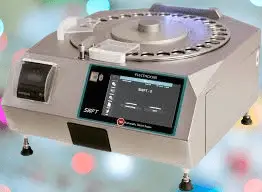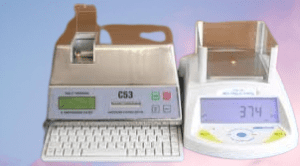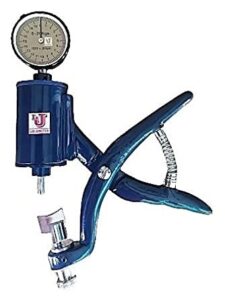A hardness tester is a device used to measure the resistance of a material to deformation or indentation. It is commonly used in the manufacturing and construction industries to ensure the quality and durability of materials such as metals, plastics, and ceramics. Hardness testers come in various types, including Rockwell, Brinell, Vickers, and Knoop testers, and use different methods to determine hardness. Accurate hardness measurements are critical in selecting appropriate materials for specific applications, and in detecting material defects or inconsistencies.
Tablet hardness tester:
A tablet hardness tester is a device used in the pharmaceutical industry to measure the hardness of tablets. Tablet hardness is an important quality control parameter for tablets, as it affects their disintegration, dissolution, and drug release properties.
The tablet hardness tester works by applying a specific amount of force to the tablet and measuring the amount of force required to break or fracture the tablet. This force is usually expressed in units of Newtons (N) or kilograms-force (kgf).
There are different types of tablet hardness testers available, including manual, semi-automatic, and fully automatic models. Manual testers require the user to apply the force manually using a hand-operated lever, while semi-automatic and fully automatic testers use a motorized mechanism to apply the force.
Tablet hardness testers can also measure other tablet properties, such as thickness, diameter, and weight. Some models also come with software that allows for data logging and analysis.
Overall, the tablet hardness tester is an important tool in the quality control process of tablet production, ensuring that tablets meet the required specifications for hardness and other properties.
Loads of hardness testing.
There are several standard loads used in hardness testing, including:
- Rockwell: Uses a minor load of 10 kgf and a major load of 60, 100, or 150 kgf, depending on the scale.
- Brinell: Uses a load of 500, 750, or 3000 kgf, depending on the hardness of the material.
- Vickers: Uses a load of 1 kgf, 2.5 kgf, 5 kgf, 10 kgf, or 30 kgf, depending on the hardness of the material.
- Knoop: Uses a load of 10 gf or 50 gf, depending on the hardness of the material.
The load applied during a hardness test is important because it affects the depth and size of the indentation made on the material surface, which in turn affects the accuracy of the hardness measurement. Therefore, it is important to select the appropriate load for the material being tested to ensure accurate and reliable hardness test results.
Working Principle of Tablet Hardness Tester
The working principle of a tablet hardness tester involves applying a specific amount of force to the tablet and measuring the force required to break or deform it. The force is typically applied by a spring-loaded mechanism, which compresses the tablet between two flat surfaces.
The tablet is placed between the upper and lower anvils of the hardness tester. The upper anvil is attached to a load cell, which measures the force applied to the tablet. The lower anvil is fixed in position.
The operator then activates the compression mechanism, which applies a specific force to the tablet. The force required to break or deform the tablet is measured by the load cell, and the result is displayed on the digital readout of the hardness tester.
There are different types of hardness testers available, each using a different method for applying force and measuring hardness. For example, the Vickers hardness tester uses a diamond indenter to create a square-shaped impression on the surface of the tablet, and the size of the impression is used to calculate the hardness of the tablet.
You may also read about Tablet Coating Machines.
Types of Tablet hardness Tester Machines:
There are different types of tablet hardness tester machines available, each with its own specific features and benefits. Some common types of tablet hardness testers include:
- Manual Tablet Hardness Tester: This type of tester requires the user to apply the force manually using a hand-operated lever. Manual testers are simple to use and require minimal maintenance.
- Semi-Automatic Tablet Hardness Tester: This type of tester uses a motorized mechanism to apply force to the tablet, but the operator still needs to place the tablet in position manually. Semi-automatic testers are faster and more accurate than manual testers.
- Fully Automatic Tablet Hardness Tester: This type of tester is fully automated and can handle a large number of tablets at once. The tester automatically places the tablet in position, applies the force, and records the results. Fully automatic testers are the fastest and most accurate type of hardness tester.
- Multi-Station Tablet Hardness Tester: This type of tester has multiple stations that can test several tablets at once, allowing for high throughput and increased efficiency.
- Portable Tablet Hardness Tester: This type of tester is designed for use in the field or at remote sites, and is smaller and more portable than other types of testers.
- Inline Tablet Hardness Tester: This type of tester is integrated into the tablet production line and can test tablets as they are being produced. This allows for real-time monitoring and adjustment of the production process.
Overall, the type of tablet hardness tester used depends on the specific needs of the manufacturer and the volume of tablets being produced.

The Major Parts of a Tablet Hardness Tester Machine
- Load Cell: The load cell is the main component of the tester and measures the force applied to the tablet. It converts the force into an electrical signal, which is displayed on the digital readout of the tester.
- Anvils: The anvils are the two flat surfaces between which the tablet is placed for testing. One of the anvils is fixed, while the other is attached to the load cell.
- Compression Mechanism: The compression mechanism applies a specific force to the tablet, which is measured by the load cell. The compression mechanism can be either manual or motorized, depending on the type of tester.
- Digital Readout: The digital readout displays the force applied to the tablet in units of Newtons (N) or kilograms-force (kgf). Some testers also display other parameters such as tablet thickness, diameter, and weight.
- Control Panel: The control panel allows the operator to set the testing parameters, such as the force applied to the tablet and the duration of the test. Some testers also have software that allows for data logging and analysis.
- Housing: The housing of the tester is usually made of metal or plastic and protects the internal components from damage.
Troubleshooting steps for a tablet hardness tester
Problem | Possible Causes | Troubleshooting Steps |
| The tester displays incorrect readings | The load cell is faulty or needs calibration | Replace the load cell or recalibrate the tester |
| Tester does not display any readings | The power supply is disconnected or faulty | Check the power supply and connections |
| Tester does not apply enough force to the tablet | The compression mechanism is faulty or needs adjustment | Check the compression mechanism and adjust it as needed |
| Tester applies too much force to the tablet | The compression mechanism is faulty or needs adjustment | Check the compression mechanism and adjust it as needed |
| Tablet breaks during testing | The tablet is too brittle or weak | Adjust tablet formulation or manufacturing process |
| Tester is slow or unresponsive | Mechanical components are worn or damaged | Check and replace worn or damaged components |
| The tester produces inconsistent readings | Anvils are dirty or worn | Clean or replace anvils as needed |
| The tester produces inconsistent readings | Operator error | Train operators on proper testing techniques |
You may also read about: Flow Chart of the Microbial Limit Test


It’s impressive how these testers help ensure quality and durability in manufacturing. I appreciate the detailed explanations and practical applications you’ve shared.